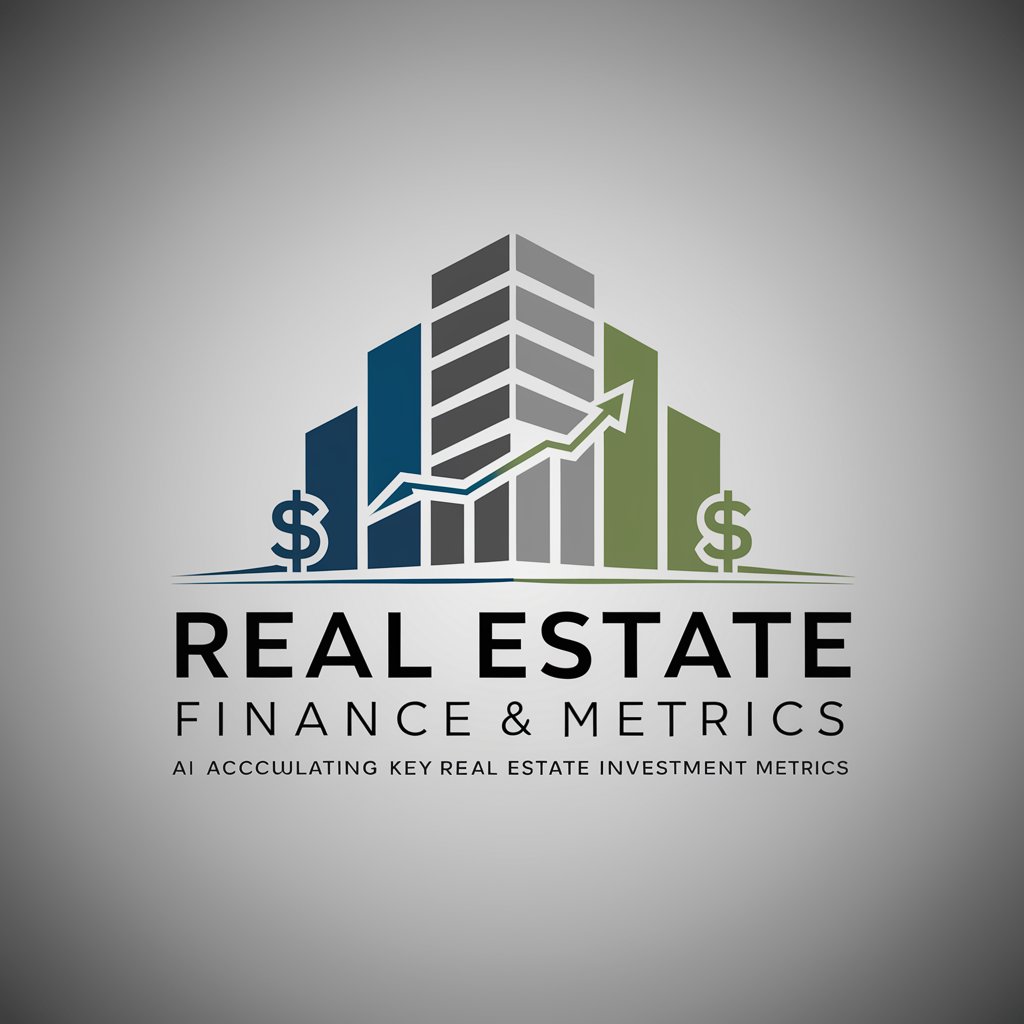
Real estate finance & metrics - Real Estate Metrics Analysis

Hello! Ready to analyze your real estate investments?
Empower Your Investments with AI-driven Insights
Calculate the Net Operating Income (NOI) for a property with the following details...
What is the Cash on Cash Return (CCR) for an investment property with these parameters...
How do I determine the Debt Coverage Rate (DCR) given the following financial information...
Can you help me find the Internal Rate of Return (IRR) for this real estate investment...
Get Embed Code
Overview of Real Estate Finance & Metrics
Real estate finance & metrics encompasses a specialized area of financial analysis focused on the evaluation and management of real estate investments. It combines principles of finance, accounting, and economics to assess the performance and potential of real estate assets. This field is crucial for making informed decisions about purchasing, selling, leasing, and financing property. By calculating key metrics such as Gross Potential Income, Net Operating Income, Cash on Cash Return, and Internal Rate of Return, investors and analysts can derive a comprehensive understanding of an investment's viability, profitability, and risk profile. For example, calculating the Net Operating Income (NOI) of a rental property involves deducting operating expenses from the Effective Gross Income (EGI), providing insight into the property's profitability before financing costs and taxes. Powered by ChatGPT-4o。

Core Functions of Real Estate Finance & Metrics
Gross Potential Income (GPI) Calculation
Example
If a multifamily property has 10 units rented at $1,200 each per month, the GPI would be $144,000 annually.
Scenario
This metric is crucial for understanding the maximum possible income from a property before considering vacancy losses or other deductions.
Net Operating Income (NOI) Analysis
Example
For a commercial property generating $500,000 in EGI and incurring $200,000 in operating expenses, the NOI would be $300,000.
Scenario
NOI is a fundamental metric used to assess the operating performance of a property, excluding the impact of financing and taxes.
Cash on Cash Return (CCR) Calculation
Example
If an investor puts down $100,000 on a property that generates $10,000 in annual cash flow, the CCR would be 10%.
Scenario
CCR offers investors a clear view of the return on their invested equity, providing a basis for comparing different investment opportunities.
Internal Rate of Return (IRR) Estimation
Example
Calculating IRR involves determining the discount rate at which the present value of all cash inflows and outflows from a property equals zero over the investment period.
Scenario
IRR is used to evaluate the profitability of potential investments, considering the time value of money and providing a comprehensive view of expected returns.
Target User Groups for Real Estate Finance & Metrics Services
Real Estate Investors
Individuals or entities looking to invest in residential, commercial, or industrial properties can benefit significantly from understanding and applying real estate metrics to assess investment opportunities and risks accurately.
Property Managers and Developers
Professionals involved in managing or developing real estate projects need to evaluate the financial performance of properties, optimize operational efficiency, and make strategic decisions about leasing, renovations, or expansions.
Financial Analysts and Advisors
Analysts specializing in real estate investments use these metrics to provide clients with advice on portfolio diversification, risk assessment, and achieving long-term investment goals.
Academic Researchers and Students
Individuals studying real estate finance, economics, or related fields can deepen their understanding of market dynamics and investment strategies by applying theoretical knowledge to practical, real-world scenarios.

Guidelines for Using Real Estate Finance & Metrics
Initiate Your Journey
Start by visiting yeschat.ai for a complimentary trial, accessible immediately without the need for logging in or subscribing to ChatGPT Plus.
Identify Your Needs
Determine which real estate investment metrics are crucial for your analysis, such as NOI, Cash Flow, or IRR, to tailor the tool's functionality to your project.
Input Property Data
Provide detailed information about your property, including rentable units, operating expenses, financing details, and expected income, to ensure accurate metric calculations.
Analyze the Metrics
Utilize the tool to calculate key investment metrics, leveraging its in-depth formulas and real-time data analysis capabilities for informed decision-making.
Optimize Investment Strategies
Apply the insights gained from the calculated metrics to refine your investment strategies, enhancing profitability and minimizing risks.
Try other advanced and practical GPTs
Data Science Buddy
Empower Your Data Science Journey with AI

Investment Muse GPT
Empowering Finance with AI-driven Insights

Investment Insight Bot
Empowering Your Investment Journey with AI

Financial Advisor
AI-powered Personal Financial Advisor

IA Module Generator
Craft Your Adventure with AI

Common Curriculum Chatbot
AI-Powered Curriculum Enhancement

Bloom Investing Analyst
Empowering Your Financial Decisions with AI

Compassionate Guide
Empathetic AI for Emotional Wellness

ED - Your AI team
Unlock creativity with AI-powered brainstorming.

SanchessAI
Empowering Communication with AI

Study Buddy
Empowering Your Study Journey with AI

Roma Learning Companion
Empower your Roma culture exploration with AI.

Detailed Q&A on Real Estate Finance & Metrics
What is Gross Potential Income and how is it calculated?
Gross Potential Income (GPI) represents the total possible income from all rentable units in a property, assuming 100% occupancy and no rental income loss. It's calculated by summing up the annual rent expected from every unit at full capacity.
How does Effective Gross Income differ from GPI?
Effective Gross Income (EGI) is derived from GPI by adjusting for vacancy losses and adding other income sources. It reflects the actual expected income, incorporating potential vacancies and additional revenue streams beyond rent.
What are Operating Expenses in real estate investment?
Operating Expenses (OPEX) include all costs incurred in the day-to-day operation of the property, such as maintenance, management fees, utilities, and property taxes. These expenses exclude mortgage payments or capital expenditures.
How do you calculate Net Operating Income?
Net Operating Income (NOI) is calculated by subtracting Operating Expenses (OPEX) from Effective Gross Income (EGI). NOI represents the property's profitability before financing and tax considerations.
What is the significance of the Internal Rate of Return in real estate investments?
The Internal Rate of Return (IRR) is a comprehensive metric that estimates the profitability of a real estate investment, considering the time value of money. It helps investors compare the potential returns of different investments on a similar scale.





